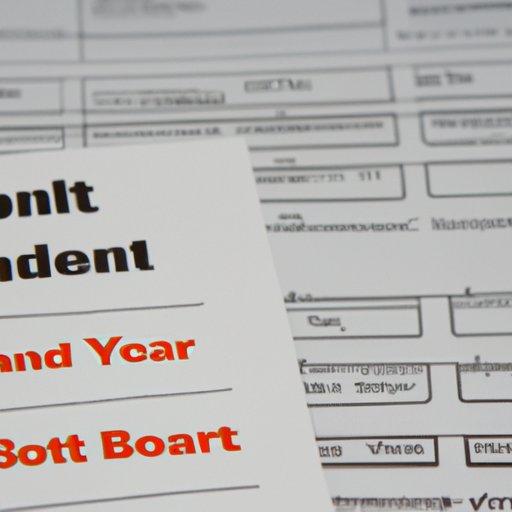Introduction
Bonds are a type of debt security that are issued by governments, corporations, or other organizations in order to raise money. When an investor buys a bond, they are essentially lending money to the issuer in exchange for interest payments over time. Bonds can be a great way to diversify an investment portfolio, as they offer some stability and potential for steady returns while also providing protection against stock market volatility.
However, there are both benefits and risks to investing in bonds, and it is important to understand these before making any decisions. This article will explore what bonds are and look at the different types of bonds available, along with their associated risks and potential returns. It will also examine the pros and cons of bond investing and the different tax implications to consider.

Analyzing Different Types of Bonds and Their Potential Returns
There are three main types of bonds available for investors to choose from: government bonds, corporate bonds, and municipal bonds. Each type of bond comes with its own set of risks and rewards, so it is important to understand the differences between them before making any decisions.
Government Bonds
Government bonds, also known as treasuries, are issued by national governments in order to finance their operations. They are considered the safest type of bond because they are backed by the full faith and credit of the issuing government. Government bonds typically have lower yields than other types of bonds, but they offer more security and are less exposed to default risk.
Corporate Bonds
Corporate bonds are issued by companies in order to raise capital. These bonds are generally higher yielding than government bonds, but they come with a greater level of risk since companies are more likely to default on their debt obligations than governments. Corporate bonds can also be affected by changes in the overall economy, so it is important to carefully assess the creditworthiness of a company before investing.
Municipal Bonds
Municipal bonds are issued by local governments, such as states and cities, in order to fund infrastructure projects and other public services. These bonds are generally attractive to investors because they are exempt from federal taxes, and in some cases, state and local taxes as well. Municipal bonds typically have lower yields than other types of bonds, but they can be a good option for those looking for tax-advantaged investments.
Exploring Pros and Cons of Bond Investing
Bond investing can be a great way to diversify your portfolio and achieve long-term financial goals. Here are some of the key benefits and drawbacks to consider.
Low-Risk Investment
Bonds are generally considered to be low-risk investments since the issuer is obligated to pay back the principal amount of the bond at maturity. This makes them a great option for those who are looking for stable returns without taking on too much risk.
Potential for Steady Returns
Bonds offer investors the potential for steady returns over time, as they typically pay out regular interest payments. This can be especially beneficial for those looking to generate a steady stream of income.
Tax Implications
The tax implications of bond investing vary depending on the type of bond you invest in. For instance, municipal bonds are exempt from federal taxes, while corporate bonds may be subject to capital gains taxes. It is important to research the tax implications of any bond before investing.
Lack of Liquidity
One of the drawbacks of investing in bonds is the lack of liquidity. Once you purchase a bond, you are locked into the investment until the bond matures, meaning you cannot easily access your funds if needed. This can be a problem for those who need access to their money quickly.

Examining Risks Involved with Bond Investing
While bonds can be a great way to diversify your portfolio, there are risks involved with investing in them. Here are some of the key risks to consider.
Interest Rate Risk
Interest rate risk refers to the risk that rising interest rates will reduce the value of bonds. This is because when interest rates go up, the price of existing bonds goes down, and vice versa. This risk is particularly relevant to government bonds, which are often used as a benchmark for setting other interest rates.
Credit/Default Risk
Credit or default risk refers to the risk that the issuer of the bond will not be able to make the promised interest payments or repay the principal amount of the bond at maturity. This risk is particularly relevant to corporate bonds, as companies are more likely to default on their debt obligations than governments.
Inflation Risk
Inflation risk refers to the risk that the purchasing power of the bond’s interest payments will be eroded by inflation. This is a particular concern for investors who hold bonds for longer periods of time, as inflation can significantly reduce the real value of the bond’s interest payments.
Comparing Different Bonds and their Yields
When evaluating which bonds to invest in, it is important to compare the yields of different bonds. Here is a brief overview of the yields associated with different types of bonds.
U.S. Treasury Bonds
U.S. Treasury bonds typically have the lowest yields of all types of bonds, but they are generally considered to be the safest type of bond. The yield on U.S. Treasury bonds varies depending on the term of the bond, but it is typically around 1-2%.
Corporate Bonds
Corporate bonds typically have higher yields than U.S. Treasury bonds, but they also come with a greater level of risk. The yield on corporate bonds varies depending on the creditworthiness of the issuer, but it is typically around 3-6%.
Municipal Bonds
Municipal bonds typically have the highest yields of all types of bonds, but they are also the most tax-advantaged. The yield on municipal bonds varies depending on the issuer, but it is typically around 2-4%.

Exploring Tax Implications of Bond Investing
It is important to understand the tax implications of investing in bonds, as this can have a significant impact on your returns. Here are some of the key tax considerations to keep in mind.
Federal Income Tax
The interest payments received on most bonds are subject to federal income tax. However, municipal bonds are exempt from federal income tax, making them an attractive option for those looking for tax-advantaged investments.
State and Local Taxes
The interest payments received on municipal bonds may be subject to state and local taxes, depending on the state where the investor resides. It is important to research the tax laws in your state before investing in municipal bonds.
Capital Gains Tax
If you sell a bond before it matures, you may owe capital gains tax on any profits you make. Capital gains tax is calculated based on the difference between the purchase price and the sale price of the bond.
Evaluating the Best Bonds to Invest In for Your Personal Investment Goals
When evaluating which bonds are best for your personal investment goals, there are several factors to consider. Here are some of the key things to keep in mind.
Consider Your Risk Tolerance
It is important to consider your risk tolerance when investing in bonds. Government bonds are generally the safest type of bond, but they also offer the lowest yields. On the other hand, corporate bonds offer higher yields but also come with a greater level of risk.
Consider Your Investment Horizon
It is also important to consider your investment horizon when investing in bonds. Longer-term bonds tend to offer higher yields, but they also come with more risk since they are exposed to interest rate fluctuations. Shorter-term bonds offer lower yields but are also less exposed to interest rate risk.
Consider Your Financial Goals
Finally, it is important to consider your financial goals when investing in bonds. If your goal is to generate income, then bonds with higher yields may be a better option. On the other hand, if your goal is to preserve capital, then lower-yielding bonds may be a better choice.
Conclusion
Investing in bonds can be a great way to diversify your portfolio and achieve your long-term financial goals. It is important to understand the different types of bonds available, as well as the associated risks and tax implications. By researching and evaluating different bonds, you can make an informed decision about which bonds are best for your personal investment goals.
(Note: Is this article not meeting your expectations? Do you have knowledge or insights to share? Unlock new opportunities and expand your reach by joining our authors team. Click Registration to join us and share your expertise with our readers.)
